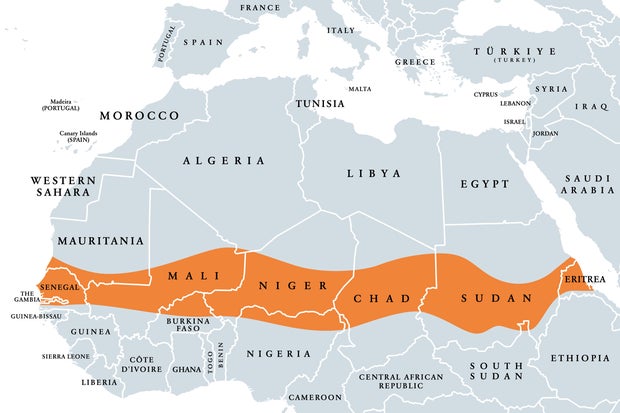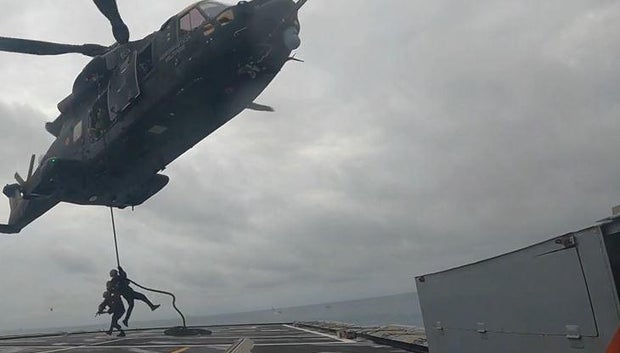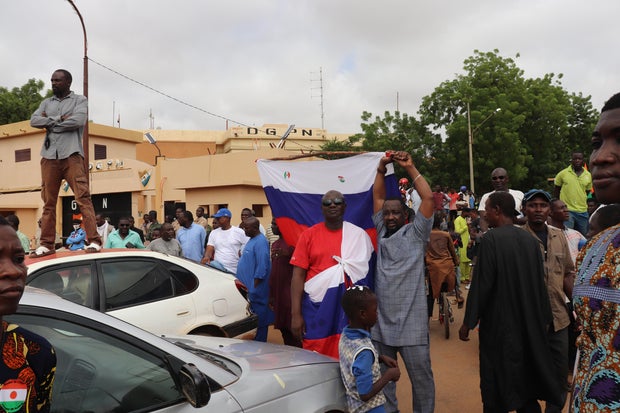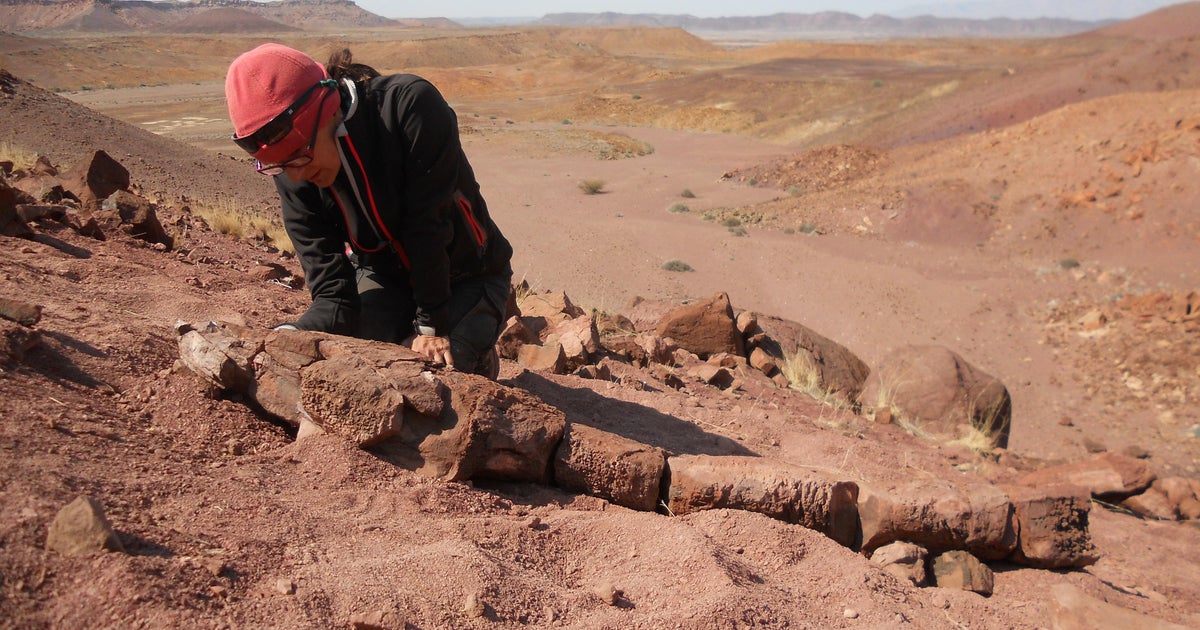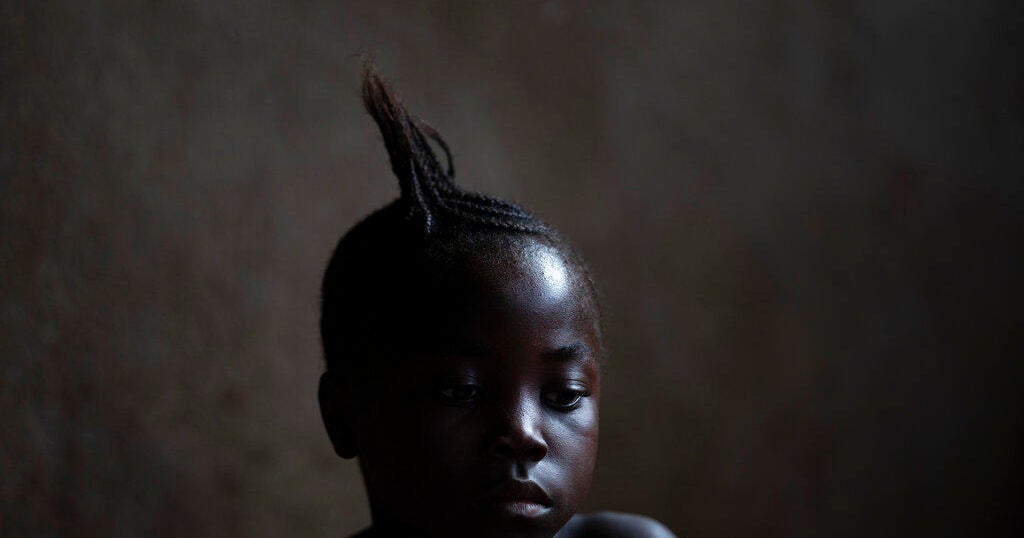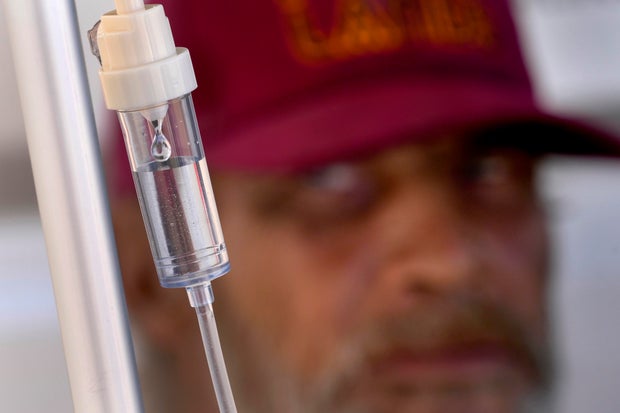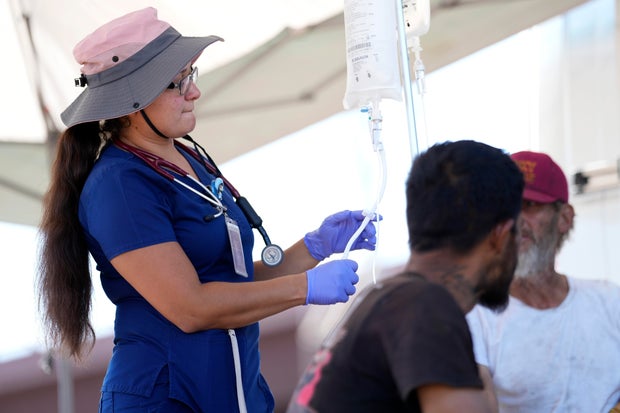CBS News
Inside a huge U.S. military exercise in Africa to counter terrorism and Russia and China’s growing influence

Tamale, Ghana — On a dusty airport tarmac in the northern Ghanaian city of Tamale, military special operatives from across Africa move stealthily. Shots ring out as they converge on the airport and apprehend armed militants holding it hostage.
It’s not a real attack, but just one of the exercises of “Flintlock,” the U.S. military’s premier counterterrorism training event in Africa, which is now in its 20th year.
Special ops teams from the U.S. military’s Africa Command, along with NATO allies, are conducting drills alongside soldiers from countries including Ghana, Ivory Coast, Chad, Mauritania, Nigeria, Libya and Morocco.
In the exercise CBS News witnessed, the elite forces were rescuing hostages from a simulated attack on an airport. It’s a very real scenario in the vast North African region known as the Sahel, which is considered the epicenter of the global fight against ISIS and al Qaeda franchises.
Getty/iStockphoto
The Sahel stretches from Mauritania in the west through Mali, Burkina Faso and Niger, all the way to Eritrea and Djibouti on Africa’s east coast, and it is home to the fastest growing and most deadly terror groups in the world.
Ghana is one of the few countries in the region that has managed to dodge the rapid rise of violent extremism — blocking any potential incursions before they reach its borders.
Gen. Frank Tei of the Ghana Armed Forces told CBS News that was vital, because “once you allow terrorist activities in a particular country to fester and blossom, then that place can become a base from which a lot of other terrorist activities can spread across the globe.”
That’s exactly what the U.S. fears and is trying to help prevent.
The deputy AFRICOM commander, Lt. Gen. John Brennan, told CBS News that the Flintlock exercise is not only about training African forces to defend themselves and combat terrorism, however.
“We offer things that are meaningful in the long term — sharing democratic values, instilling rule of law,” he said.
But that hasn’t worked out so well over the past decade. There have been 11 coups in the Sahel alone over that period, and at least 14 leaders of those armed government overthrows were trained at Flintlock.
Brennan told CBS News the military tracks these leaders, and while there are strict rules of engagement with any country in which the government has been toppled by a military junta, “the hope is that you keep contact with the military partners and then you pull them away from military-led governments, which never last.”
So how can the U.S. ensure the skills taught at events like Flintlock are not later weaponized and used to subvert democracy?
Brennan is quick to point out that executing a coup is a political maneuver, not a military one.
“We teach them how to protect their forces in combat and then conduct successful counterterrorism operations. That has nothing to do with overthrowing a government. It’s just some of the people we’ve trained are military and they’re involved in some of the coups,” he said. “But history has shown … democracy ends up prevailing in a lot of countries.”
Flintlock has expanded to include maritime training — including rappelling onto a moving warship hijacked by armed militants. American forces, along with Italian and Dutch soldiers, put African troops through their paces on a frigate off the Ghanaian coast.
CBS News
This aspect of the exercises is increasingly important, given that the Sahel region runs all the way to the Red Sea, where the Iran-backed Houthi rebels have been launching attacks targeting international shipping and U.S. naval vessels.
The annual Flintlock training operation — hosted this year by Ghana — could not have come at a more crucial time for the U.S. military, as American influence is arguably in deep decline across the vast African continent.
The U.S. is up against stiff competition. China offers Africa’s national leaders trade agreements and Russia offers military aid, and all with very few strings attached. Washington, meanwhile, has been booted off one key front line in the fight against terrorism, after the more than 1,000 troops AFRICOM had stationed in Niger were ordered to leave the country by September following a coup there last year.
Djibo Issifou/picture alliance via Getty Images
The U.S. has two military bases in Niger, including a drone command center in the city of Agadez that cost more than $110 million to set up.
Russia quickly stepped in to exploit the power vacuum created by the coup. Mercenaries from the former Wagner Group, now called Africa Corps and run by the Russian government, arrived in Niger in April.
In a scenario that was not long ago unimaginable, the Russian and American forces now occupy opposite sides of the same sprawling air base.
That has sent alarm bells ringing in Washington, and U.S. Ambassador to Ghana Virginia Palmer stressed to CBS News that African nations should understand that Russia’s offer of security forces does not come completely without strings attached.
“It’s important that our African partners understand that what the Russians are offering is, maybe regime protection — it’s certainly not national security,” Palmer said.
She said African countries do pay for the services offered by Moscow, and at a cost that “is extraordinarily high.”
Niger is rich in uranium, which can be used to make nuclear weapons. What Russia provides is military muscle in exchange for mineral wealth, but unlike the U.S., the deal comes with no potentially tricky human rights questions being asked.
“But time will tell that that decision is probably not a good one,” the ambassador said. “So, you don’t feed your kids ice cream for dinner every night because they want it, right? You feed them vegetables, you feed them spinach, things that are good for them … instant gratification is probably not a recipe for success.”
U.S. law restricts the provision of military aid to armed forces believed to be guilty of human rights abuses, but many leaders on the continent accuse Washington of having double standards — saying the U.S. withholds aid from some African nations while giving Israel billions of dollars despite global condemnation of its actions in the war in Gaza.
It’s a charge that Brennan disputes.
“I don’t think there’s a double standard,” he told CBS News. “I can tell you our values and the people we do partner with — even after coups — we’re still able to influence them.”
African countries argue that it isn’t just training they need, but resources and modern military equipment if they hope to counter rising extremism.
Brennan stressed that the U.S. carries with it the weight of the entire NATO alliance, unlike its competitors, but he conceded that Washington must “be able to resource our partners appropriately, and really expand the relationship with them … to help make Africa prosperous, free and a partner of choice.”
With Flintlock, the U.S. promises long-term investment in the African continent. But that long-view security strategy is competing for African partnerships amid a fast-growing terror threat, on a battlefield crowded with malign actors.
CBS News
Meet the designer turning classic Venetian glass into modern art

Watch CBS News
Be the first to know
Get browser notifications for breaking news, live events, and exclusive reporting.
CBS News
Minnesota Vikings rookie Khyree Jackson dies in car accident

MINNEAPOLIS — Minnesota Vikings rookie Khyree Jackson died overnight in a car accident.
The Upper Marlboro, Maryland native played for Alabama and Oregon. He was drafted by the Vikings in April in round 4 as the 108th overall pick.
He was 24 years old.
“Our thoughts are with Khyree’s family, friends, teammates and coaches, as well as all the victims of this tragic accident,” the Vikings wrote on X.
Vikings head coach Kevin O’Connell said he was “crushed” by the news of Jackson’s death.
“In our short time together, it was evident Khyree was going to develop into a tremendous professional football player, but what was more impressive was his desire to become the best person he could be for his family and those around him,” O’Connell added.
The crash happened in Upper Marlboro shortly after 3 a.m. and involved three cars, according to Maryland state police. Investigators believe the driver of a silver Infiniti car tried to change lanes at a high rate of speed and struck the car that Jackson was in, as well as a Chevrolet Impala.
The two other occupants of Jackson’s car also died in the crash. The occupants of the other cars were not hurt.
Officials believe that alcohol could have been a contributing factor in the crash.
In a statement, the Minnesota Vikings say they have offered support to Jackson’s family, and are offering counseling and emotional support to the players who seek it.
This is a developing story. Check back with WCCO.com for more.
Note: The above video first aired on June 24, 2024.
CBS News
Street medics treat heat illnesses among homeless people as temperatures rise

Alfred Handley leaned back in his wheelchair alongside a major Phoenix freeway as a street medicine team helped him get rehydrated with an intravenous saline solution dripping from a bag hanging on a pole.
Cars whooshed by under the blazing 96-degree morning sun as the 59-year-old homeless man with a nearly toothless smile got the help he needed through a new program run by the nonprofit Circle the City.
“It’s a lot better than going to the hospital,” Handley said of the team that provides health care to homeless people. He’s been treated poorly at traditional clinics and hospitals, he said, more than six years after being struck by a car while he sat on a wall, leaving him in a wheelchair.
Circle the City, a non-profit that works in multiple cities and hospitals and treats about 9,000 people annually, introduced its IV rehydration program as a way to protect homeless people in Phoenix from life-threatening heat illness as temperatures regularly hit the triple-digits in America’s hottest metro.
Matt York / AP
Homeless people accounted for nearly half of the record 645 heat-related deaths last year in Maricopa County, which encompasses metro Phoenix. As summers grow warmer, health providers from San Diego to New York are being challenged to better protect homeless patients.
Dr. Liz Frye, vice chair of the Street Medicine Institute which provides training to hundreds of healthcare teams worldwide, said she didn’t know of groups other than Circle the City administering IVs on the street. The organization also distributes tens of thousands of water bottles each summer and tries to educate people about hot weather dangers.
“But if that’s what needs to happen to keep somebody from dying, I’m all about it,” Frye said.
Bringing care to people in need
The amount of people requiring treatment for heat illnesses is rising. The Boston Health Care for the Homeless Program, featured in last year’s book, “Rough Sleepers,” now sees patients with mild heat exhaustion in the summer after decades of treating people with frostbite and hypothermia during the winter, said Dr. Dave Munson, the street team’s medical director.
“It’s certainly something to worry about,” said Munson, noting that temperatures in Boston hit 100 degrees with 70% humidity during June’s heat wave. Homeless people, he said, are vulnerable to very hot and very cold weather not only because they live outside, but they often can’t regulate body temperature due to medication for mental illness or high blood pressure, or because of street substance use.
The Phoenix team searches for patients in homeless encampments in dry riverbeds, sweltering alleys and along the canals that bring water to the Phoenix area. About 15% are dehydrated enough for a saline drip.
Matt York / AP
“We go out every day and find them,” said nurse practitioner Perla Puebla. “We do their wound care, medication refills for diabetes, antibiotics, high blood pressure.”
Puebla’s street team ran across Handley and 36-year-old Phoenix native Phillip Enriquez near an overpass in an area frequented by homeless people because it’s near a facility offering free meals. Across the road was an encampment of tents and lean-tos along a chain-link fence.
Enriquez sat on a patch of dirt as Puebla started a drip for him. She also gave him a prescription for antibiotics and a referral to a dentist for his dental infection.
Living outside in Arizona’s broiling sun is hard, especially for people who may be mentally ill or use sedating drugs like fentanyl that make them less aware of their surroundings. Stimulants like methamphetamine contribute to dehydration, which can be fatal. Dr. Matt Essary, who works with Circle in the City’s mobile clinics, said the organization also often treats surface burns that can happen when a medical emergency or intoxication causes someone to fall on a sizzling sidewalk.
Matt York / AP
Temperatures this year have reached 115 degrees in metro Phoenix, where six heat-related deaths have been confirmed through June 22. Another 111 are under investigation, and the city is seeing an “increasing” number of patients with heat illnesses every year, according to Dr. Aneesh Narang, the assistant medical director of emergency medicine at Banner Medical Center-Phoenix, which treats many homeless people with heat stroke.
Narang’s staff works frequently with Circle the City, whose core mission is providing respite care, with 100 beds for homeless people not well enough to return to the streets after a hospital stay.
Extreme heat worldwide requires a dramatic response, said physician assistant Lindsay Fox, who cares for homeless people in Albuquerque, New Mexico, through an initiative run by the University of New Mexico’s School of Medicine.
Three times weekly, Fox treats infections, cleans wounds and manages chronic conditions in consultation with hospital colleagues. She said the prospect of more heat illness worries her.
Highs in Albuquerque can hit the 90s and don’t fall enough for people living outside to cool off overnight, she said.
“If you’re in an urban area that’s primarily concrete, you’re retaining heat,” she said. “We’re seeing heat exposure that very quickly could go to heat stroke.”
Serious heat stroke is far more common in metro Phoenix, where Circle the City is now among scores of health programs for the homeless in cities like New York, San Diego and Spokane, Washington.
Circle the City works with medical staff in seven Phoenix hospitals to help homeless patients get after-care when they no longer need hospitalization. It also staffs two outpatient clinics for follow-up.
Rachel Belgrade waited outside Circle the City’s retrofitted truck with her black-and-white puppy, Bo, for Essary to write a prescription for the blood pressure medicine she lost when a man stole her bicycle. She accepted two bottles of water to cool off as the morning heat rose.
“They make all of this easier,” said Belgrade, a Native American from the Gila River tribe. “They don’t give you a hard time.”


